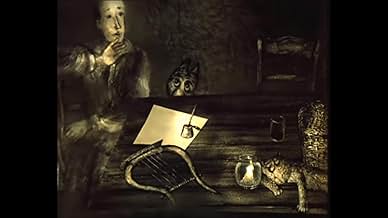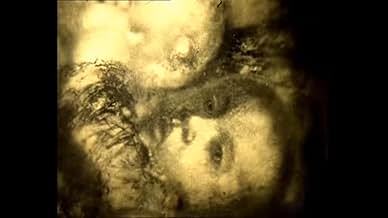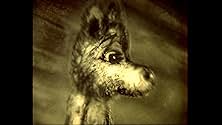AVALIAÇÃO DA IMDb
7,8/10
4,4 mil
SUA AVALIAÇÃO
Adicionar um enredo no seu idiomaDistant, well-worn memories of childhood are inhabited by a little gray wolf. Through astonishing imagery, the memory of all of Russia is depicted.Distant, well-worn memories of childhood are inhabited by a little gray wolf. Through astonishing imagery, the memory of all of Russia is depicted.Distant, well-worn memories of childhood are inhabited by a little gray wolf. Through astonishing imagery, the memory of all of Russia is depicted.
- Direção
- Roteiristas
- Artista
- Prêmios
- 2 vitórias no total
Aleksandr Kalyagin
- Little Grey Wolf
- (narração)
- Direção
- Roteiristas
- Elenco e equipe completos
- Produção, bilheteria e muito mais no IMDbPro
Avaliações em destaque
In most people's head the animation film is connected to Disney movies or to Japanese manga animation films, which are very hip nowadays. But everyone seems to overlook Russian animators. The most influential of them is Yuri Norstein, whose timeless masterpiece was awarded at the festival of animation films in Los Angeles in 1984 and at many other film festivals throughout the world. But why is this short half-an-hour movie so beautiful?
Firstly, because Norstein has a matchless visual style. I expected something special after I've read about the film and before I saw it but what I got is something extraordinary: breathtaking pictures, fantastically clever use of mixed media, fine classical music. Secondly, because of the complex, symbol-ridden story, which is rooted in the Russian mythology. The story is about childhood innocence, the loss of the loved ones and the duty of the artist. It's very European, very Eastern-European and because I'm from Hungary and our past is very similar, this animation film is much closer to me than the American or Japanese ones.
Firstly, because Norstein has a matchless visual style. I expected something special after I've read about the film and before I saw it but what I got is something extraordinary: breathtaking pictures, fantastically clever use of mixed media, fine classical music. Secondly, because of the complex, symbol-ridden story, which is rooted in the Russian mythology. The story is about childhood innocence, the loss of the loved ones and the duty of the artist. It's very European, very Eastern-European and because I'm from Hungary and our past is very similar, this animation film is much closer to me than the American or Japanese ones.
Grand Prize winner at the Zagreb World Festival of Animated Films Russian director Yuri Norstein's Tale of Tales (alternately titled The Little Grey Wolf Will Come) was named by the 1984 Animation Olympiad jury at the L.A. Olympics as the greatest animated film of all time. Written by Ludmilla Petrushevskaya and Norstein, like Tarkovsky's Zerkalo (The Mirror), it consists of fleeting images, snippets of memory from the director's life. According to Norstein, the film was inspired by the poem Tale of Tales by Nazim Hikmet:
"We stand above the water - sun, cat, plane tree, me and our destiny. The water is cool, The plane tree is tall, The sun is shining, The cat is dozing, I write verses. Thank God, we live!"
The film opens with a grey wolf singing a Russian lullaby to a baby in a cradle:
"Baby baby rock-a-bye On the edge you mustn't lie Or the little grey wolf will come And will nip you on the tum Tug you off into the wood Underneath the willow-root."
Backed by an original score by Mikhail Meerovich and the music of Bach and Mozart, images roll by, some repeated during the film, without any apparent connection: a sad eyed grey wolf nurturing a little baby, a boy eating a green apple, then feeding it to the crows, a passive bull skipping rope with a small girl, men and women's dancing interrupted by soldiers, a woman sitting on a bench with her drunk husband, a man and his son wearing Napoleon hats ostensibly going off to war, women mourning the death of loved ones in the war, apples falling in the snow, among others. Norstein describes the film as being "about simple concepts that give you the strength to live."
Claire Kitson, former Commissioning Editor of Animation for the UK's Channel 4, in her book about the film: Yuri Norstein and Tale of Tales – An Animator's Journey by Clare Kitson. London, U.K., & Bloomington, IN: John Libbey & Indiana University Press, 2005), says that the images are not metaphors but actual events in the director's life. For instance, the woman sitting in a bench with a drunk husband comes from a couple casually spotted by co-writer Lyudmila Petrushevskaya, the apple from a happy and tasty experience of Norstein eating an apple while walking in the street during the winter, and the old house from the actual house that he dwelled in during his childhood.
But she warns that "the film is about memory and ...is also constructed like a memory" and adds: "this is achieved by the construction of a set of parallel worlds: the old house with, nearby, an old streetlight and the setting for wartime scenes; the poet's world, where a fisherman's family also lives and a bull and a walker come to visit; the snowbound winter world of the boy and the crows; and the forest next to a highway, where the Little Wolf makes his home under the brittle willow bush. In short, we must appreciate bull, poet, wolf, house, snow and so on not like metaphors of something else, but like bricks in a palace, notes in a symphony."
Selecting it as one of the fifteen greatest "seeking" films of all time, directors Gregory and Maria Pears described it on their website www.cinemaseekers.com as follows: "Through its philosophical depths, its visionary language and its use of sound and music, it raises animation to the level of the very best art cinema. Norstein is a consummate artist, who insists on painting every frame himself. The result is the totally unique evocation of his spiritual world that could only have been rendered through animation - no other cinematic form would have sufficed."
Enigmatic, magically beautiful, and very moving, Tale of Tales is a work of art that you cannot figure out but can only experience just by letting it roll over you like a warm breeze.
The 27-minute film is available on You Tube with English subtitles.
http://www.youtube.com/watch?v=b_q3WoYawNI
"We stand above the water - sun, cat, plane tree, me and our destiny. The water is cool, The plane tree is tall, The sun is shining, The cat is dozing, I write verses. Thank God, we live!"
The film opens with a grey wolf singing a Russian lullaby to a baby in a cradle:
"Baby baby rock-a-bye On the edge you mustn't lie Or the little grey wolf will come And will nip you on the tum Tug you off into the wood Underneath the willow-root."
Backed by an original score by Mikhail Meerovich and the music of Bach and Mozart, images roll by, some repeated during the film, without any apparent connection: a sad eyed grey wolf nurturing a little baby, a boy eating a green apple, then feeding it to the crows, a passive bull skipping rope with a small girl, men and women's dancing interrupted by soldiers, a woman sitting on a bench with her drunk husband, a man and his son wearing Napoleon hats ostensibly going off to war, women mourning the death of loved ones in the war, apples falling in the snow, among others. Norstein describes the film as being "about simple concepts that give you the strength to live."
Claire Kitson, former Commissioning Editor of Animation for the UK's Channel 4, in her book about the film: Yuri Norstein and Tale of Tales – An Animator's Journey by Clare Kitson. London, U.K., & Bloomington, IN: John Libbey & Indiana University Press, 2005), says that the images are not metaphors but actual events in the director's life. For instance, the woman sitting in a bench with a drunk husband comes from a couple casually spotted by co-writer Lyudmila Petrushevskaya, the apple from a happy and tasty experience of Norstein eating an apple while walking in the street during the winter, and the old house from the actual house that he dwelled in during his childhood.
But she warns that "the film is about memory and ...is also constructed like a memory" and adds: "this is achieved by the construction of a set of parallel worlds: the old house with, nearby, an old streetlight and the setting for wartime scenes; the poet's world, where a fisherman's family also lives and a bull and a walker come to visit; the snowbound winter world of the boy and the crows; and the forest next to a highway, where the Little Wolf makes his home under the brittle willow bush. In short, we must appreciate bull, poet, wolf, house, snow and so on not like metaphors of something else, but like bricks in a palace, notes in a symphony."
Selecting it as one of the fifteen greatest "seeking" films of all time, directors Gregory and Maria Pears described it on their website www.cinemaseekers.com as follows: "Through its philosophical depths, its visionary language and its use of sound and music, it raises animation to the level of the very best art cinema. Norstein is a consummate artist, who insists on painting every frame himself. The result is the totally unique evocation of his spiritual world that could only have been rendered through animation - no other cinematic form would have sufficed."
Enigmatic, magically beautiful, and very moving, Tale of Tales is a work of art that you cannot figure out but can only experience just by letting it roll over you like a warm breeze.
The 27-minute film is available on You Tube with English subtitles.
http://www.youtube.com/watch?v=b_q3WoYawNI
Using a mix of puppet, cutout, and cell animation, Yuri Norstein made in Tale of Tales a heartbreaking, tenderly poetic meditation on Russian history as well as one of the most stunningly beautiful animated films ever. Very hard to get, but don't miss a chance to see this film.
This would be the ultimate 3D film experience. I wanted to see this again as preparation for Tarkovsky's "Nostalghia" (1983), which I've long regarded as one of the most amazing films ever made. This, I think, exhibits the same kind of existential meta-melancholy that's somehow deeply rooted in the fabric of the creative process depicted by many of the Russian artists; then, as noted, this has an amazingly perceptive visual eye making it more than a fitting prelude.
It's like entering an infant's dream. Everything is new, nothing is named. What we see is emotion. Color as emotion, motion as emotion, character as emotion. The layered images are stunning, and the eye moves restlessly, zooming in and out on objects and is at times perplexingly active as if it didn't know where it was going, and at times hesitantly passive.
Dreams of a dreamed up being, the maroon light swallowing the thin silhouette-like figures. The minotaur-like figure jumping rope. The wolf, alone in the forest at the fire, taken in by the mysterious light (a sure influence on Polanski and his The Ninth Gate [1999]). This must've been a great influence on Chomet, as well.
This is on par with and in my estimation exceeds "L'Homme qui plantait as arbres" (1988), and a very worthy companion for the best of the Quay Brothers as short animation that reshapes how we see and think, and most importantly, how we dream.
It's like entering an infant's dream. Everything is new, nothing is named. What we see is emotion. Color as emotion, motion as emotion, character as emotion. The layered images are stunning, and the eye moves restlessly, zooming in and out on objects and is at times perplexingly active as if it didn't know where it was going, and at times hesitantly passive.
Dreams of a dreamed up being, the maroon light swallowing the thin silhouette-like figures. The minotaur-like figure jumping rope. The wolf, alone in the forest at the fire, taken in by the mysterious light (a sure influence on Polanski and his The Ninth Gate [1999]). This must've been a great influence on Chomet, as well.
This is on par with and in my estimation exceeds "L'Homme qui plantait as arbres" (1988), and a very worthy companion for the best of the Quay Brothers as short animation that reshapes how we see and think, and most importantly, how we dream.
Not much to add really to what's already been said before, and so well too. Tale of Tales is one of the finest Soviet animations ever made alongside Hedgehog in the Fog, and one of the most powerful and poignant of the entire animation medium too. The visuals are really striking, atmospherically coloured and impeccably detailed, several of the images are enough to stay with you forever and the symbolic ones are really quite meaningful. Tale of Tales is scored wonderfully too, all of it fits with the visuals like strawberries and cream whether ethereally beautiful in the retrospective moments or hauntingly rousing in the war/battle images. The story and atmosphere are rendered adeptly, the story is structured into three sections, each of them is firmly focused and full of emotional impact and they follow and overlap one another with no signs of jarring or clumsiness. The retrospective moments are nostalgic and poignant, the middle section is just gut-wrenching and the idealism of the final section shows some hope, contrasting beautifully with what's been seen before. Tale of Tales is well-paced, it allows the visuals to breathe and resonate nor does it descend into tedium, and the powerful, affecting and nostalgic atmosphere is incredibly well-done. To conclude, a fine example of a Soviet animation masterpiece and one of the finest examples too. 10/10 Bethany Cox
Você sabia?
- CuriosidadesThe sound of the baby drinking his milk was actually the sound of a puppy, and the sad eyes of the wolf were copied from a magazine picture of a rescued kitten.
- ConexõesFeatured in Animated Century (2003)
- Trilhas sonorasUtomlyonnoe solntse
Written by Jerzy Petersburski
Russian lyrics by Iosif Alvek
Performed by Aleksandr Tsfasman
Principais escolhas
Faça login para avaliar e ver a lista de recomendações personalizadas
Detalhes
Bilheteria
- Faturamento bruto mundial
- US$ 82.099
Contribua para esta página
Sugerir uma alteração ou adicionar conteúdo ausente
















